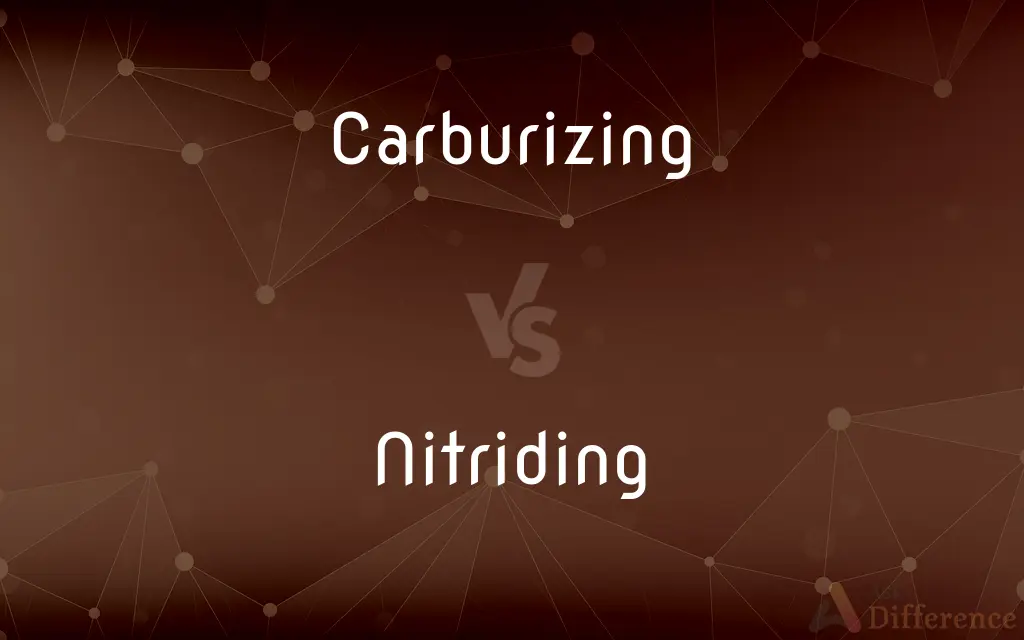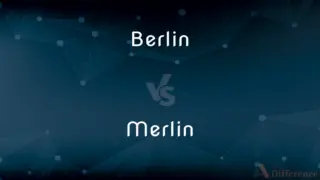Carburizing vs. Nitriding — What's the Difference?
Edited by Tayyaba Rehman — By Fiza Rafique — Updated on March 12, 2024
Carburizing involves adding carbon to a steel surface, enhancing hardness and wear resistance, while nitriding introduces nitrogen for surface hardening with less distortion.

Difference Between Carburizing and Nitriding
Table of Contents
ADVERTISEMENT
Key Differences
Carburizing is a heat treatment process that involves exposing steel to a carbon-rich environment at high temperatures to increase the carbon content on its surface. This process enhances the hardness, wear resistance, and fatigue strength of the steel. On the other hand, nitriding is another surface hardening technique where nitrogen is introduced to the surface of a steel part. Unlike carburizing, nitriding is performed at lower temperatures and does not involve a change in the carbon content of the steel.
Carburizing is typically applied to low carbon steel parts that require a hard surface and a tough core, such as gears and camshafts. Nitriding is suitable for alloy steels and is used to improve wear resistance, fatigue strength, and corrosion resistance.
Carburizing generally requires the steel to be heated to a temperature where it is in an austenitic phase, followed by quenching to lock the carbon in the surface. This process creates a high-carbon surface layer with a gradient of carbon concentration, leading to a hard surface and a softer core. Nitriding, however, is performed at temperatures below the austenitizing temperature, which means the steel's microstructure is not significantly altered. The result is a thin, hard layer formed by the diffusion of nitrogen, which provides excellent wear resistance without the need for quenching and the associated risks of distortion.
The choice between carburizing and nitriding depends on the specific requirements of the part being treated. Carburizing offers deeper case depths and is ideal for parts that require high surface hardness combined with a tough core. Nitriding, while offering shallower case depths, provides excellent surface hardness with minimal dimensional changes, making it suitable for precision parts.
Comparison Chart
Process
Adds carbon to the surface
Adds nitrogen to the surface
ADVERTISEMENT
Temperature
High (above austenitizing)
Lower (below austenitizing)
Material
Low carbon steel
Alloy steels
Distortion
Higher risk due to quenching
Lower due to no quenching
Application
Gears, camshafts
Precision parts, tools
Compare with Definitions
Carburizing
Process of adding carbon to the surface of steel to increase hardness.
Carburizing gears improves their wear resistance.
Nitriding
Surface hardening process involving nitrogen.
Nitriding the valve improves its resistance to wear.
Carburizing
Involves heating steel in a carbon-rich environment.
The gear was heated in a carburizing furnace for surface hardening.
Nitriding
Performed at lower temperatures than carburizing.
Nitriding was chosen to minimize distortion of the precision part.
Carburizing
Suitable for low carbon steel parts.
Low carbon steel components are often carburized to enhance performance.
Nitriding
Does not require quenching, reducing distortion.
The nitriding process avoided the warping associated with quenching.
Carburizing
Enhances wear resistance and fatigue strength of steel.
Carburized steel parts are more durable in heavy machinery.
Nitriding
Provides excellent wear and corrosion resistance.
Nitrided surfaces are highly resistant to corrosion.
Carburizing
Creates a hard surface with a tough core.
Carburizing provides the shaft with a hard exterior while maintaining a tough interior.
Nitriding
Ideal for alloy steels.
Alloy steel gears are often nitrided to improve their surface hardness.
Carburizing
Carburising, carburizing (chiefly American English), or carburisation is a heat treatment process in which iron or steel absorbs carbon while the metal is heated in the presence of a carbon-bearing material, such as charcoal or carbon monoxide. The intent is to make the metal harder.
Nitriding
Nitriding is a heat treating process that diffuses nitrogen into the surface of a metal to create a case-hardened surface. These processes are most commonly used on low-alloy steels.
Carburizing
To treat, combine, or impregnate with carbon, as when casehardening steel.
Nitriding
A method of case hardening steel by the surface absorption of nitrogen by heating with ammonia.
Carburizing
To carburet.
Carburizing
Present participle of carburize
Common Curiosities
What is nitriding?
Nitriding is a surface hardening technique that introduces nitrogen into the surface of steel, improving wear resistance and fatigue strength.
Can both carburizing and nitriding be applied to all types of steel?
Carburizing is generally suitable for low carbon steels, whereas nitriding is more suited for alloy steels.
How do carburizing and nitriding differ in process temperatures?
Carburizing is done at higher temperatures above the austenitizing point, while nitriding is performed at lower temperatures below the austenitizing point.
What is carburizing?
Carburizing is a heat treatment process that increases the carbon content on the surface of steel to enhance hardness and wear resistance.
How does the depth of hardness compare between carburized and nitrided surfaces?
Carburizing generally provides deeper case depths, while nitriding offers shallower but very hard surface layers.
Does carburizing affect the entire part or just the surface?
Carburizing primarily affects the surface, creating a hard exterior while maintaining a tougher interior.
Why is there less distortion in nitrided parts compared to carburized parts?
Nitriding does not require quenching, which is a step in carburizing that can cause distortion due to rapid cooling.
Can carburizing improve fatigue strength?
Yes, carburizing enhances both wear resistance and fatigue strength of steel parts.
How do carburizing and nitriding affect the wear resistance of steel?
Both processes significantly improve the wear resistance of steel, with carburizing providing a deeper hardened surface and nitriding offering a very hard but thinner surface layer.
What are the typical applications for carburizing?
Carburizing is commonly used for parts that need a hard surface and a tough core, such as gears and camshafts.
Is nitriding good for improving corrosion resistance?
Yes, in addition to wear resistance, nitriding also enhances the corrosion resistance of steel surfaces.
What are the environmental considerations for carburizing and nitriding?
Both processes involve high temperatures and chemical treatments, requiring careful handling and disposal of treatment gases and chemicals to minimize environmental impact.
What makes nitriding suitable for precision parts?
The process induces minimal dimensional changes, making it ideal for precision parts that require tight tolerances.
What is the risk of distortion in carburizing?
Carburizing involves quenching, which can lead to higher risks of part distortion due to thermal stress.
Why is nitriding chosen for alloy steels?
Nitriding is effective on alloy steels because it enhances surface hardness without altering the steel's inherent properties.
Share Your Discovery

Previous Comparison
Loyalty vs. Honesty
Next Comparison
Berlin vs. MerlinAuthor Spotlight
Written by
Fiza RafiqueFiza Rafique is a skilled content writer at AskDifference.com, where she meticulously refines and enhances written pieces. Drawing from her vast editorial expertise, Fiza ensures clarity, accuracy, and precision in every article. Passionate about language, she continually seeks to elevate the quality of content for readers worldwide.
Edited by
Tayyaba RehmanTayyaba Rehman is a distinguished writer, currently serving as a primary contributor to askdifference.com. As a researcher in semantics and etymology, Tayyaba's passion for the complexity of languages and their distinctions has found a perfect home on the platform. Tayyaba delves into the intricacies of language, distinguishing between commonly confused words and phrases, thereby providing clarity for readers worldwide.














































